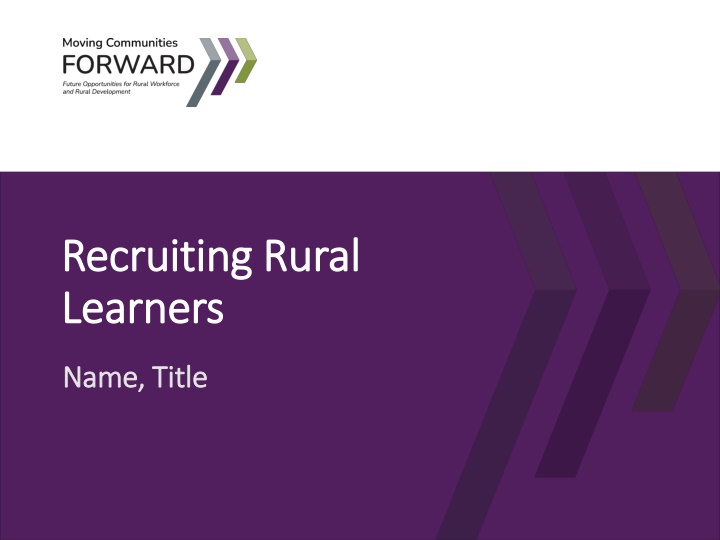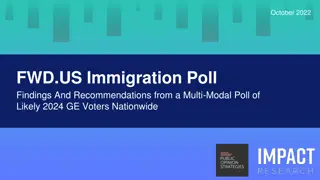
Enhancing Rural Workforce Recruitment and Retention Strategies
Explore the importance of recruitment and retention planning for rural areas facing challenges in attracting and retaining learners and employees. Learn about demographic trends, BIPOC and ALICE populations, and creating effective community plans to address gaps and opportunities for attracting talent. Discover the strengths and assets that make rural communities appealing for individuals and families to thrive.
Download Presentation

Please find below an Image/Link to download the presentation.
The content on the website is provided AS IS for your information and personal use only. It may not be sold, licensed, or shared on other websites without obtaining consent from the author. If you encounter any issues during the download, it is possible that the publisher has removed the file from their server.
You are allowed to download the files provided on this website for personal or commercial use, subject to the condition that they are used lawfully. All files are the property of their respective owners.
The content on the website is provided AS IS for your information and personal use only. It may not be sold, licensed, or shared on other websites without obtaining consent from the author.
E N D
Presentation Transcript
Recruiting Rural Recruiting Rural Learners Learners Name, Title Name, Title
Why focus on recruitment and retention planning? Over the past several decades many small and rural areas have struggled to recruit and retain rural learners and employees at the same rate of suburban and urban peers. The U.S. Census Bureau (2020) estimates that while rural areas declined by a half-percent between 2010 and 2020, urban and suburban areas grew by eight percent.
Data on Demographic Trends Data on demographic trends: Conversations with rural students/learners BIPOC populations: Who lives here? What do our BIPOC populations tell us about our community? What are the historical demographic trends What are their needs? (This may include community change, livability suggestions, access to training and resources, etc.) What are the major industries? What is the average education level of the community? Key informant interviews: What are the identified needs in workforce development? How can we recruit more employees to the community? What is the future of the community if we don t make a change?
BIPOC and ALICE Populations ALICE BIPOC When thinking about recruiting and retaining a rural workforce, it is important for us to consider how we are being intentional about recruiting, supporting, and retaining Black, Indigenous, and People of Color (BIPOC) Asset limited, income constrained, employed (ALICE) is a way to talk about employees who are employed, make an income above the federal poverty level, but not enough money to meet the day-to-day demands of basic needs.
Creating a Plan As this section will help each stakeholder map the assets in rural communities which are important to list when beginning to think about why a family or individual would move or stay in the community.
Why our community? Being honest about the assets in the community and the challenges will allow the community to begin addressing ways to recruit and retain rural learners and employees. What are the strengths in your community? Why would someone choose to live here? Are there excellent schools? Low crime rates? A strong sense of connectedness and community? Low cost of living? Where are the gaps/opportunities to address livability? Affordable housing? Access to quality health care? Spaces for BIPOC communities
Activity 1- Community Strengths and Gaps (opportunities) What are the strengths in your community? Why would someone choose to live here? Where are the gaps/opportunities to address livability?
Who? In order to recruit, we must first understand who we are trying to recruit.
Activity 2: Planning Who are you targeting? Using sticky notes write characteristics of the ideal candidate (ex. entrepreneurs, desire to work in a technology field, ability to speak Spanish, etc.) One characteristic per sticky note
Activity 3: Recruitment - Why you? Developing a value proposition for your industry/business
Best Practices for Recruitment As we go through these next sections, we want to think about our draft outreach plan. A good plan is one that can be tweaked as needed. As you hear an idea that you would want to incorporate into your plan, feel free to make those changes.
Case Study In Oregon, high school graduation rates were continuing to decline among Hispanic/Latino students. This decline in graduation rates meant many students were not able to attend college, apply for many jobs, or advance in careers. Schools came to the OSU Extension Service for ways to help. A curriculum out of North Carolina State University, called Juntos [Who-n-toes] was discovered as a way to teach families and students, together, about how the education system works, how to apply for college, and ways to engage with the school system. OSU Extension intentionally designed the program to reduce barriers for attendance by the whole family. These program components included: providing the workshop at 5:30 with a hot and culturally-relevant meal for families and offering childcare inside the facility. In order to build trust and relationships with the schools, Juntos is physically located in the high schools and middle school and administrators are encouraged to attend, even if they do not speak the language. By the end of the next school year, 50 families had attended the program and 100% of students had graduated high school, and 92% of those students went on to college.
Retention Organizational/business culture What is your culture? Define your culture in 1-2 sentences Do employees feel like they are supported by leadership/management? Have you asked current employees/learners what their needs are, and if they are satisfied? Is there a culture of being able to bring up issues? How would you describe the team dynamics? On-going training Is there a scheduled plan for on-going professional development? How are skills developed over time with learners/employees? What are the opportunities for leadership development?






















